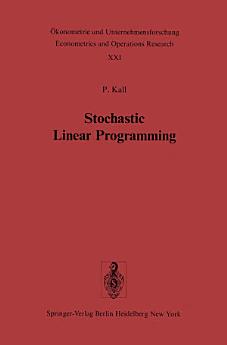Stochastic Linear Programming
ທ.ວ. 2012 · Springer Science & Business Media
ປຶ້ມອີບຸກ
96
ໜ້າ
reportບໍ່ໄດ້ຢັ້ງຢືນການຈັດອັນດັບ ແລະ ຄຳຕິຊົມ ສຶກສາເພີ່ມເຕີມ
ກ່ຽວກັບປຶ້ມ e-book ນີ້
Todaymanyeconomists, engineers and mathematicians are familiar with linear programming and are able to apply it. This is owing to the following facts: during the last 25 years efficient methods have been developed; at the same time sufficient computer capacity became available; finally, in many different fields, linear programs have turned out to be appropriate models for solving practical problems. However, to apply the theory and the methods of linear programming, it is required that the data determining a linear program be fixed known numbers. This condition is not fulfilled in many practical situations, e. g. when the data are demands, technological coefficients, available capacities, cost rates and so on. It may happen that such data are random variables. In this case, it seems to be common practice to replace these random variables by their mean values and solve the resulting linear program. By 1960 various authors had already recog nized that this approach is unsound: between 1955 and 1960 there were such papers as "Linear Programming under Uncertainty", "Stochastic Linear Pro gramming with Applications to Agricultural Economics", "Chance Constrained Programming", "Inequalities for Stochastic Linear Programming Problems" and "An Approach to Linear Programming under Uncertainty".
ໃຫ້ຄະແນນ e-book ນີ້
ບອກພວກເຮົາວ່າທ່ານຄິດແນວໃດ.
ອ່ານຂໍ້ມູນຂ່າວສານ
ສະມາດໂຟນ ແລະ ແທັບເລັດ
ຕິດຕັ້ງ ແອັບ Google Play Books ສຳລັບ Android ແລະ iPad/iPhone. ມັນຊິ້ງຂໍ້ມູນໂດຍອັດຕະໂນມັດກັບບັນຊີຂອງທ່ານ ແລະ ອະນຸຍາດໃຫ້ທ່ານອ່ານທາງອອນລາຍ ຫຼື ແບບອອບລາຍໄດ້ ບໍ່ວ່າທ່ານຈະຢູ່ໃສ.
ແລັບທັອບ ແລະ ຄອມພິວເຕີ
ທ່ານສາມາດຟັງປຶ້ມສຽງທີ່ຊື້ໃນ Google Play ໂດຍໃຊ້ໂປຣແກຣມທ່ອງເວັບຂອງຄອມພິວເຕີຂອງທ່ານໄດ້.
eReaders ແລະອຸປະກອນອື່ນໆ
ເພື່ອອ່ານໃນອຸປະກອນ e-ink ເຊັ່ນ: Kobo eReader, ທ່ານຈຳເປັນຕ້ອງດາວໂຫຼດໄຟລ໌ ແລະ ໂອນຍ້າຍມັນໄປໃສ່ອຸປະກອນຂອງທ່ານກ່ອນ. ປະຕິບັດຕາມຄຳແນະນຳລະອຽດຂອງ ສູນຊ່ວຍເຫຼືອ ເພື່ອໂອນຍ້າຍໄຟລ໌ໄໃສ່ eReader ທີ່ຮອງຮັບ.






